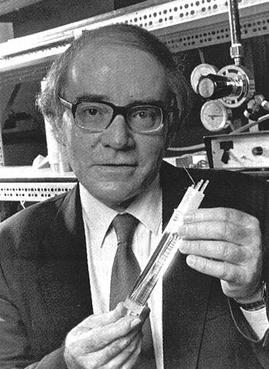Martin Fleischmann facts for kids
Quick facts for kids
Martin Fleischmann
|
|
|---|---|

Fleischmann showing part of his cold fusion test apparatus
|
|
| Born | 29 March 1927 |
| Died | 3 August 2012 (aged 85) |
| Nationality | British |
| Citizenship | British |
| Alma mater | Imperial College London |
| Known for | Fundamental electrochemistry, work on cold fusion |
| Awards | Fellow of the Royal Society |
| Scientific career | |
| Fields | Electrochemistry |
| Institutions | Durham University, Newcastle University, University of Southampton, University of Utah, IMRA |
| Notable students | Stanley Pons |
Martin Fleischmann (born March 29, 1927 – died August 3, 2012) was a British chemist. He was known for his work in electrochemistry, which is the study of how electricity and chemical reactions are connected. He also became famous for his research with Stanley Pons on something called "cold fusion." They announced their findings early, which caused a lot of excitement but also a lot of questions from other scientists.
Contents
About Martin Fleischmann's Life
Martin Fleischmann was born in 1927 in a country called Czechoslovakia. His family moved to England in 1938 to escape danger during World War II. He studied chemistry at Imperial College London and earned his PhD in 1951. He was married to his wife, Sheila, for 62 years.
Martin Fleischmann's Career in Science
Exploring Electrochemistry (1950s to 1983)
Most of Martin Fleischmann's career was spent studying electrochemistry. This field looks at how chemical reactions can create electricity, and how electricity can cause chemical reactions. He taught at several universities, including Newcastle University and the University of Southampton.
In 1967, he became a professor at the University of Southampton. He helped discover something called the Surface Enhanced Raman Scattering effect (SERS) in 1973. This discovery helps scientists study molecules on surfaces. He also developed tiny tools called ultramicroelectrodes in the 1980s. These tools are very small electrodes used to study chemical reactions in tiny spaces.
Because of his important work, he received several awards. In 1979, he won a medal from the Royal Society of London for his work in electrochemistry. In 1986, he was chosen as a Fellow of the Royal Society, which is a big honor for scientists. He stopped teaching in 1983 but continued his research.
The Cold Fusion Story (1983 to 1992)
Martin Fleischmann and his colleague Stanley Pons started working on an idea they called "cold fusion." They believed they had found a way to create nuclear fusion (the process that powers the sun) at room temperature, which would be a huge discovery. From 1983 to 1989, they used their own money to do experiments at the University of Utah.
The university decided to announce their findings at a press conference in March 1989. This was unusual because scientists usually publish their work in journals first, so other experts can review it. The news quickly spread and was called "cold fusion" by the media.
Many scientists tried to repeat Fleischmann and Pons's experiments, but most could not get the same results. This led to a lot of criticism. Other scientists said their work was not clear enough and that they should have waited to publish their research in a scientific journal. Fleischmann later said he regretted making the public announcement so early.
The scientific community found it hard to accept the "cold fusion" claims because the results were difficult to reproduce. It showed how important it is for scientific discoveries to be tested and confirmed by many different researchers.
After Retirement (from 1992)
In 1992, Fleischmann moved to France with Pons to continue their research at a special lab. He retired in 1995 and went back to England. He kept working on papers about cold fusion with other scientists from different countries.
His Passing
Martin Fleischmann passed away on August 3, 2012, at his home in England. He was 85 years old.
Martin Fleischmann's Legacy
Martin Fleischmann made many important contributions to the field of electrochemistry. He wrote over 272 scientific papers and book chapters. He helped develop the basic ideas for:
- How Potentiostats (tools used in electrochemistry) are designed.
- The use of Microelectrodes (tiny electrodes).
- Understanding how new materials form on surfaces through electrochemistry.
- Surface-enhanced Raman spectroscopy, a way to study molecules.
- Techniques using X-rays to study materials as reactions happen.
- The study of organic chemicals using electricity.
- How to apply electrochemistry in engineering.
- Using electrodes in biology.
- Understanding how metals rust (corrosion).
After his death, the Martin Fleischmann Memorial Project was started in his honor. This project gathers research from around the world related to LENR, which stands for Low Energy Nuclear Reactions, a field that continues to explore ideas similar to cold fusion.

